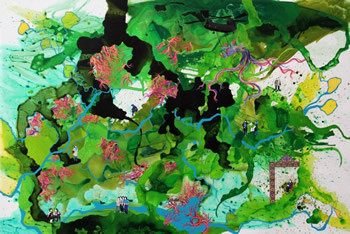Visitors will know they’ve found something special when they walk into A Leaf from My Rose Garden at SECCA, Winston-Salem’s Southeastern Center for Contemporary Art. The cohesive display of recent paintings by Hedieh Javanshir Ilchi is a mix of arrestingly colorful Western abstraction and traditional Persian art that dabbles in themes of oppression, invasion, and the demise of what is natural at the hands of what is designed.
The paintings range in complexity and the simpler iterations are better, but Curator Steven Matijcio conceals this with a show whose inventory works together brilliantly. For the title, Matijcio looked to the work of Saadi, a medieval Persian poet, and specifically to his well-known 1259 piece, Gulistan (“The Rose Garden”). The work communicates that a garden is stronger than its individual flowers (A flower endures but five or six days/But this rose-garden is always delightful).
Ilchi was born in 1981 in Tehran, where she began creative studies before moving to Washington, DC, to pursue fine art degrees. The work in the show is on either panel or mylar, a thin, plastic, non-absorbent polyester material. Ilchi, who likes that mylar is fairly new in art history, says “placing elements drawn from traditional Persian art on such a contemporary surface becomes a curious amalgamation.”
Atop white bases she applies colorful watery acrylic in swooshes and splashes, submitting it to the will of gravity and its own viscosity. Over this technicolor ground are tightly rendered geometric patterns and small Persian figures in modern dress. She has begun to experiment with texture in her most recent work, an element she would be wise to continue employing.
An example of the textural work is Quiet Invasion (2012), one of four small panels hung together and covered with goopy silver, bubbling and building with thickness and spreading thin at its edges. Using tazhib, the art of decorative illumination, she fills the negative space with a floral pattern of blue, red, and gold which creeps onto the silver, laying a leaf over the edge, or dangling small buds. As the organized invades the natural, the viewer discerns only one will survive.
The strongest pieces are those in which Ilchi most simply communicates that nothing pure remains, which, along with Quiet Invasion, include Pedantic Transgression (2011) and I Ran Like the Wind (2011). The latter addresses gender oppression, which symbolically appears in streams of electrified black hair. Ilchi aims to “evoke a sense of resilience that is a true reflection of how many Iranian women fight the daily gender battles.” The flowing hair would be kept under a Hijab in Iran; here it has rebelliously broken free. It emerges from a wave of brightly colored paint, in which splashes of bold red and magenta transition to lazy puddles and drips of saffron, peach, violet, navy, and pearlescent pink. A tazhib-style threshold connecting nothing sits atop the polychrome mess, defenseless under the reaching arms of blood-red paint above it.
In The time will glide away, but you will always remain, for nothing is as pure as you are (2011), faceless people perch randomly atop a ground of turquoise and tired greens and yellows. They converse, sit and stand, presumably unaware of the stream of black pigment entering the painting, matching a military helicopter carrying a captured Simorgh, the ancient, benevolent flying creature found in Persian mythology. The scene is ominous.
It is surprising that for all the uncomfortable themes in Ilchi’s work an inviting aura remains. The primary draw is the color. The secondary is physical, an action of bending forward to examine tiny figures and pretty patterns. It is in this posture that elements of invasion appear: the military vehicles, the tentacled hair, and other devices proving that what was thought to be true and permanent can change violently.
It is most important that visitors recognize Ilchi’s successful melding of Western and Persian artistic styles. The abstraction provides the emotion needed to communicate the ideas of invasion her symbols cannot convey on their own. Laden with an almost-sadness, she has recorded for Persia what can be said for every culture: there is a time when danger comes and things change for the worse, but this change is inevitable and survivable.
This exhibition is supported by ART + Islam, a project of the Thomas S. Kenan Institute for the Arts at the UNC School of the Arts that aims to bring a greater understanding of Islam to North Carolina through the lens of art and culture.
The show continues through September 1. For details, see the sidebar.











